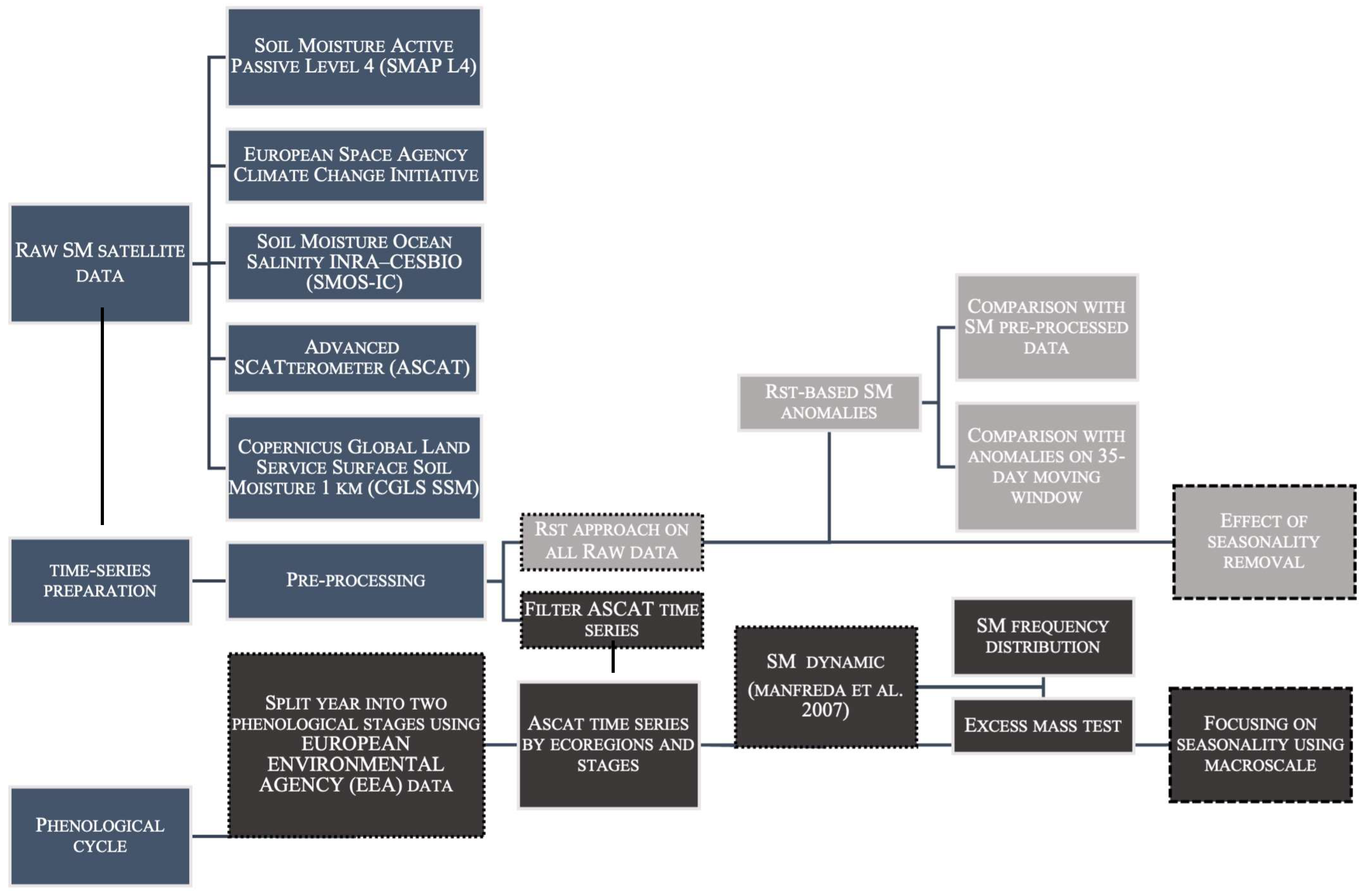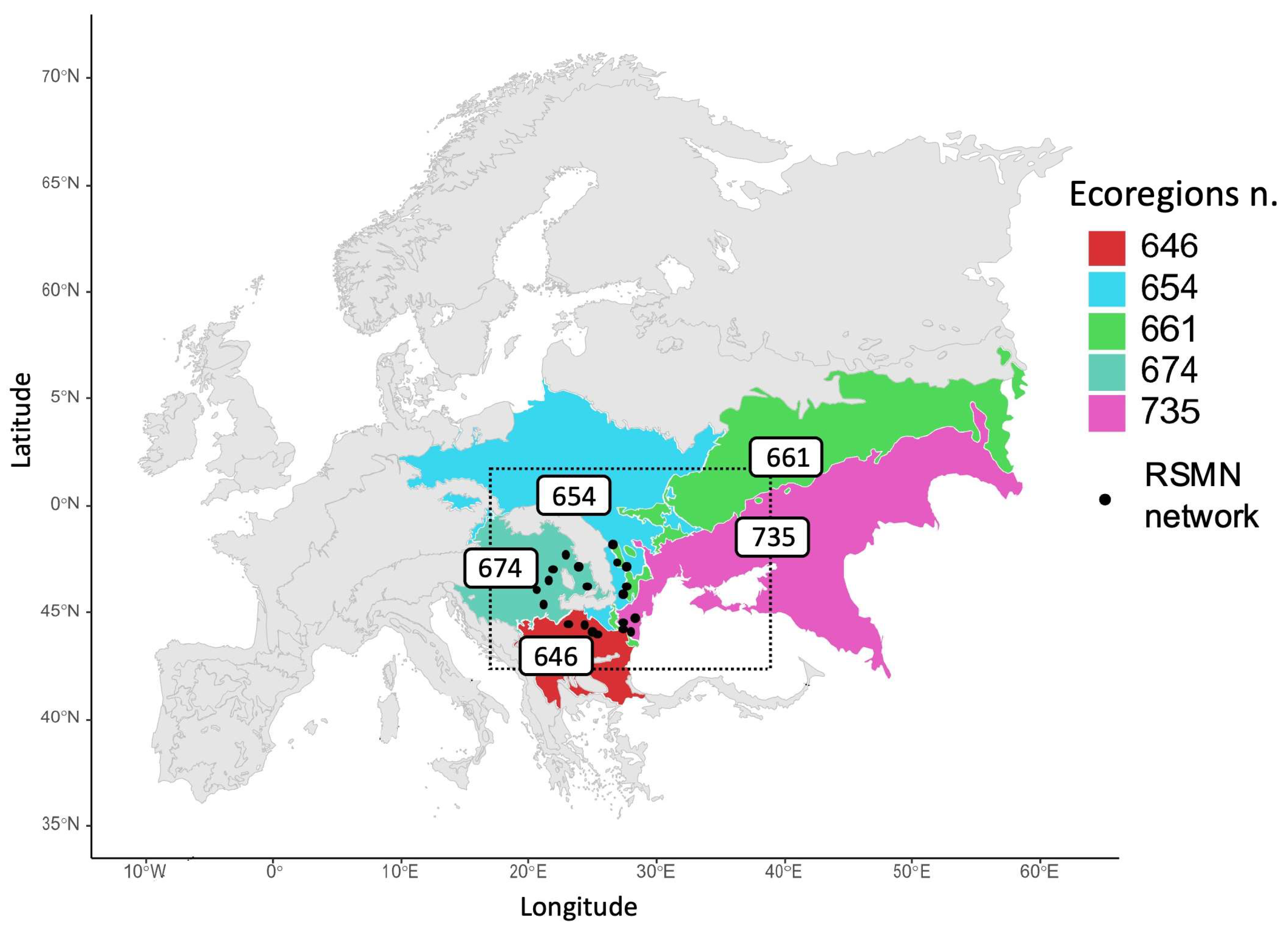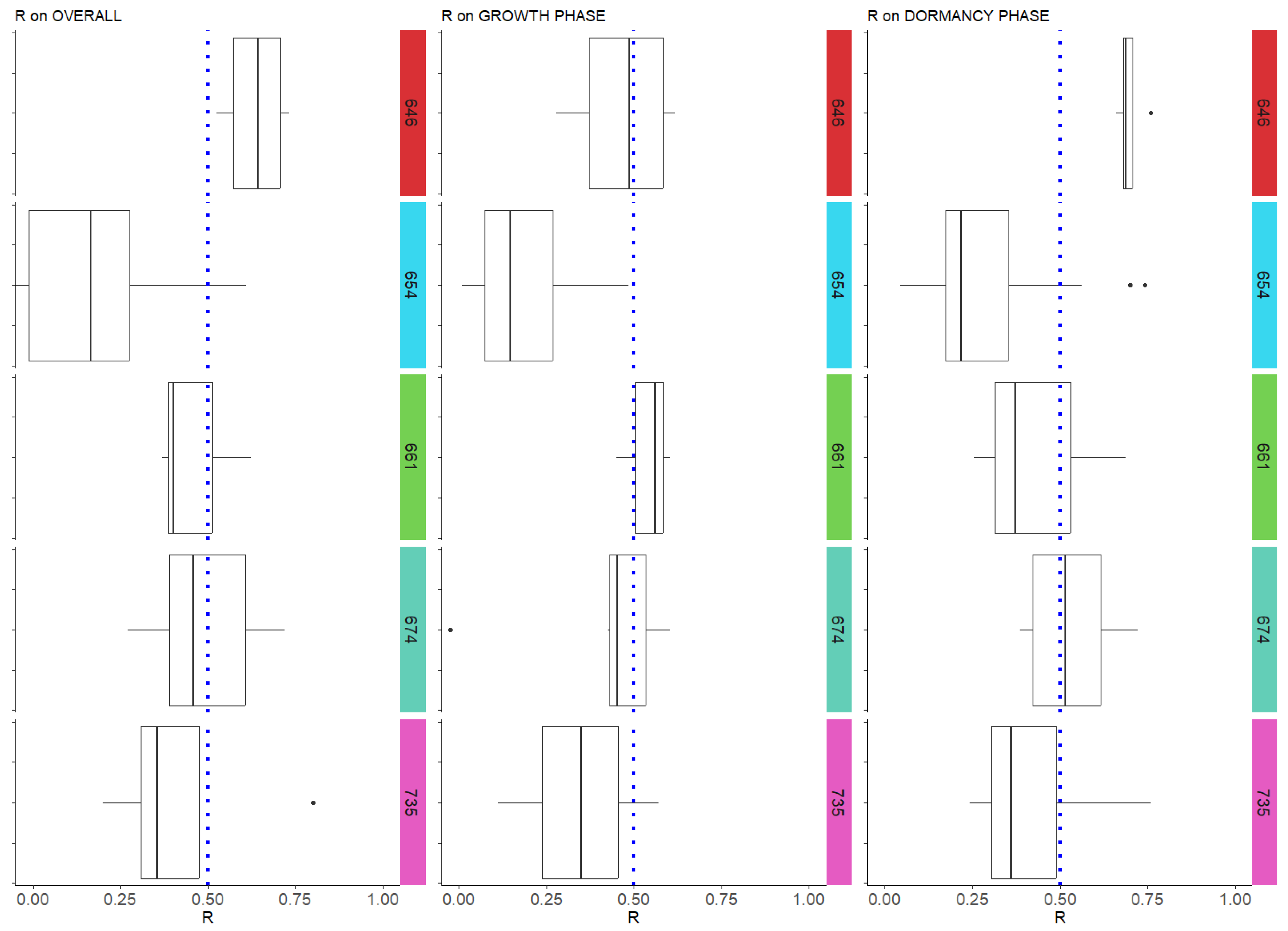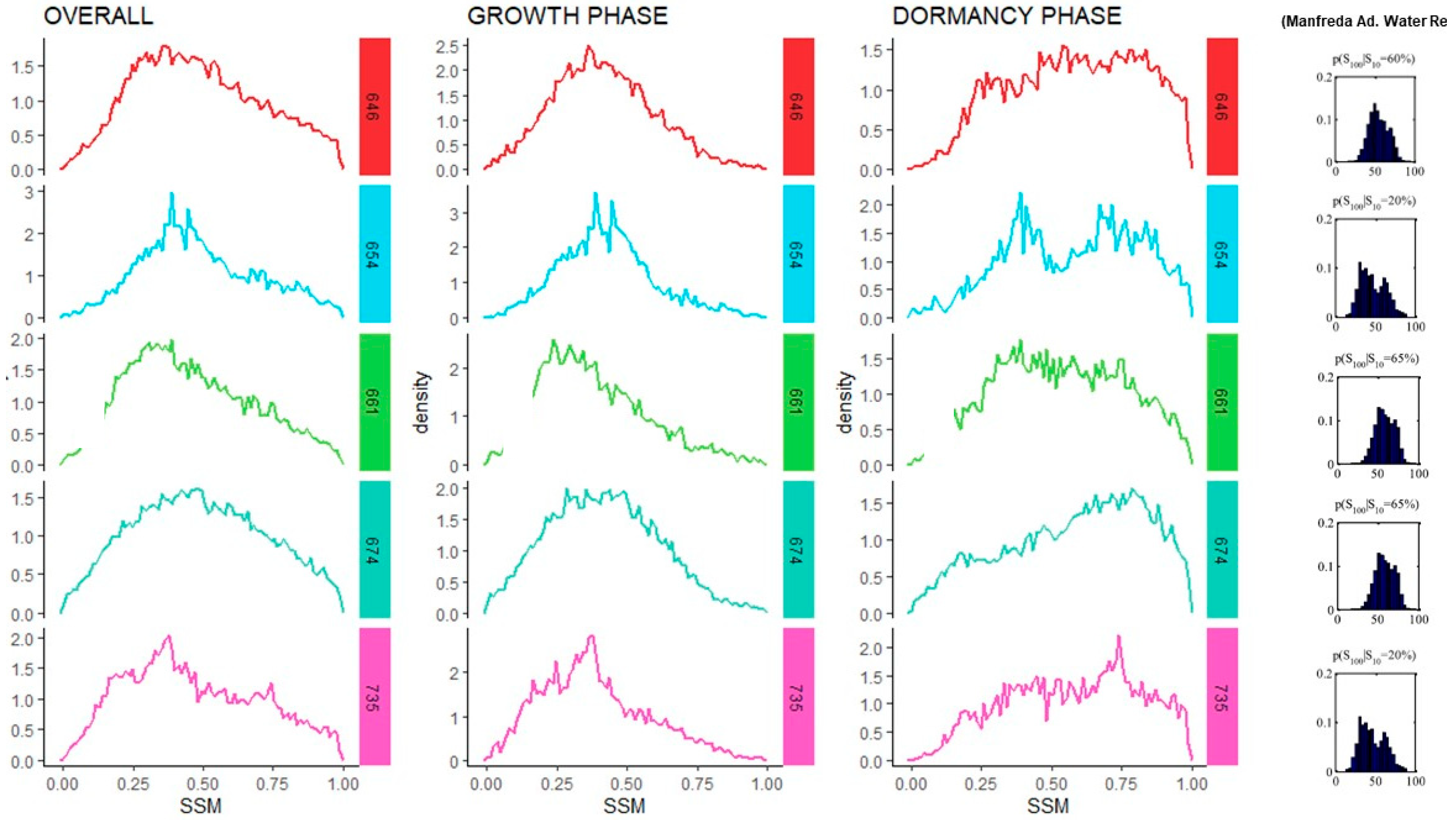How Can Seasonality Influence the Performance of Recent Microwave Satellite Soil Moisture Products?
Abstract
1. Introduction
- Short-term anomalies, i.e., high-frequency, sub-seasonal changes indicating short-term drying and wetting events.
- Long-term anomalies that include both short-term events and deviations from the long-term mean seasonal cycle, known as SM climatology [10].
2. Materials and Methods
- Data preparation: SM RS data were analyzed against in situ measurements taken within a one-hour time frame and their daily aggregation. The metrics were then computed for each station and aggregated using the ecoregion median, as reported in our previous work [19]. Based on the concept of soil moisture temporal stability [25,26,27], which posits that regional information under certain conditions stores local information, we used the results achieved for the sub-sector (in terms of median values), including the ground stations, as representative of the whole ecoregion, as had been done in the USA [5]. In Section 2.1, the ecoregions considered are highlighted, followed by a brief summary of the ISMN network (Section 2.2) and a presentation of the SM satellite products (Section 2.3).
- The 35-day moving window and RST anomaly detection approaches are described in detail in Section 2.4.
- A comparison was made between the RST-based anomalies for each satellite product and both the pre-processed original data and the anomalies derived from a 35-day moving window, with the results detailed in Section 3.1.
- The identification of vegetation growth and dormancy phases via the European Environment Agency (EEA) data is presented in Section 2.5, and the results of the evaluation of SM dynamics by phases and ecoregions on ASCAT are given in Section 3.2.
2.1. Study Area
- The Balkan mixed forests (unique identification number 646, taken from https://ecoregions.appspot.com/, accessed on 1 November 2022) have high biodiversity and pronounced seasonality, influenced by both Mediterranean and Continental climates.
- The Central European mixed forests (No. 654) are characterized by a predominantly continental climate.
- The East European forest steppe (No. 661) is a lowland region extending to the Carpathian foothills in Romania.
- The Pannonian mixed forests (No. 674) feature extensive grasslands and are bordered by the Carpathian Mountains in the northeast, affecting its climate and reducing central rainfall.
- The Pontic steppe (No. 735), located in Southeast Romania, experiences a temperate climate with notable winter rainfall.
2.2. Romanian Soil Moisture Network (RSMN) In Situ Measurements
2.3. Satellite SM Products
- the SMOS-IC version 02, available at 25 km spatial resolution in both ascending and descending (6:00 a.m./p.m.) orbits;
- the SMAPL4 v6 model assimilated product (Data Set ID: SPL4SMAU) with a 3 h time resolution on a global 9 km modeling grid;
- the Metop ASCAT Surface Soil Moisture Climate Data Records, including the H115 Metop ASCAT SSM CDR2019 and its temporal extension H116, at a 12.5 km spatial resolution, converted to volumetric units using a porosity map as in [31];
- the ESA CCI-SM v06.1 “combined” product at a 0.25° × 0.25° spatial resolution, merging scatterometer-based and radiometer-based soil moisture information.
2.4. The Remotion of Short and Long-Term Variation in SM
2.5. SM Distribution Analysis Considering the Phenological Cycle
3. Results
3.1. SM Satellite Comparison in Short- and Long-Term Variation
3.2. Effect Induced by the Phenological Cycle on SM Dynamics
4. Summary and Conclusions
Author Contributions
Funding
Data Availability Statement
Acknowledgments
Conflicts of Interest
References
- Luo, M.; Meng, F.; Sa, C.; Duan, Y.; Bao, Y.; Liu, T.; Maeyer, P.D. Response of vegetation phenology to soil moisture dynamics in the Mongolian Plateau. CATENA 2021, 206, 105505. [Google Scholar] [CrossRef]
- Albano, R.; Manfreda, S.; Celano, G. MY SIRR: Minimalist agro-hYdrological model for Sustainable IRRigation management—Soil moisture and crop dynamics. SoftwareX 2017, 6, 107–117. [Google Scholar] [CrossRef]
- Entin, J.K.; Robock, A.; Vinnikov, K.Y.; Hollinger, S.E.; Liu, S.; Namkhai, A. Temporal and spatial scales of observed soil moisture variations in the extratropics. J. Geophys. Res. 2000, 105, 11865–11877. [Google Scholar] [CrossRef]
- Li, B.; Rodell, M. Spatial variability and its scale dependency of observed and modeled soil moisture over different climate regions. Hydrol. Earth Syst. Sci. 2013, 17, 1177–1188. [Google Scholar] [CrossRef]
- Baldwin, D.; Manfreda, S.; Keller, K.; Smithwick, E.A.H. Predicting root zone soil moisture with soil properties and satellite near-surface moisture data across the conterminous United States. J. Hydrol. 2017, 546, 393–404. [Google Scholar] [CrossRef]
- Scipal, K.; Scheffler, C.; Wagner, W. Soil moisture runoff relation at the catchment scale as observed with coarse resolution microwave remote sensing, Hydrology and Earth Syst. Sciences 2005, 9, 173–183. [Google Scholar] [CrossRef]
- Scipal, K.; Drusch, M.; Wagner, W. Assimilation of a ERS scatterometer derived soil moisture index in the ECMWF numerical weather prediction system. Adv. Water Resour. 2008, 31, 1101–1112. [Google Scholar] [CrossRef]
- Albergel, C.; Rüdiger, C.; Carrer, D.; Calvet, J.-C.; Fritz, N.; Naeimi, V.; Bartalis, Z.; Hasenauer, S. An evaluation of ASCAT surface soil moisture products with in-situ observations in southwestern France. Hydrol. Earth Syst. Sci. 2009, 13, 115–124. [Google Scholar] [CrossRef]
- Lacava, T.; Brocca, L.; Calice, G.; Melone, F.; Moramarco, T.; Pergola, N.; Tramutoli, V. Soil moisture variations monitoring by AMSU-based soil wetness indices: A long-term inter-comparison with ground measurements. Remote Sens. Environ. 2010, 114, 2317–2325. [Google Scholar] [CrossRef]
- Gruber, A.; De Lannoy, G.; Albergel, C.; Al-Yaari, A.; Brocca, L.; Calvet, J.-C.; Colliander, A.; Cosh, M.; Crow, W.; Dorigo, W.; et al. Validation practices for satellite soil moisture retrievals: What are (the) errors? Remote Sens. Environ. 2020, 244, 111806. [Google Scholar] [CrossRef]
- Chakravorty, A.; Chahar, B.R.; Sharma, O.P.; Dhanya, C.T. A regional scale performance evaluation of SMOS and ESA-CCI soil moisture products over India with simulated soil moisture from MERRA-Land. Remote Sens. Environ. 2016, 186, 514–527. [Google Scholar] [CrossRef]
- Van der Schalie, R.; De Jeu, R.; Rodríguez-Fernández, N.; Al-Yaari, A.; Kerr, Y.; Wigneron, J.-P.; Parinussa, R.; Drusch, M. The effect of three different data fusion approaches on the quality of soil moisture retrievals from multiple passive microwave sensors. Remote Sens. 2018, 10, 107. [Google Scholar] [CrossRef]
- Mazzariello, A. A Four-Dimensional Soil Moisture Product: Closing the Soil Profile Gap with a SWI-SMAR Approach. Ph.D. Thesis, University of Basilicata, Potenza, Italy, 26 February 2024. [Google Scholar]
- Gruber, A.; Scanlon, T.; van der Schalie, R.; Wagner, W.; Dorigo, W. Evolution of the ESA CCI Soil Moisture climate data records and their underlying merging methodology. Earth Syst. Sci. Data 2019, 11, 717–739. [Google Scholar] [CrossRef]
- Kim, H.; Crow, W.T.; Wagner, W.; Li, X.; Lakshmi, V. A Bayesian machine learning method to explain the error characteristics of global-scale soil moisture products. Remote Sens. Environ. 2023, 296, 113718. [Google Scholar] [CrossRef]
- Haugaasen, T.; Peres, C.A. Primate assemblage structure in Amazonian flooded and unflooded forests. Am. J. Primatol. 2005, 67, 243–258. [Google Scholar] [CrossRef]
- Keenan, T.F.; Gray, J.; Friedl, M.A.; Toomey, M.; Bohrer, G.; Hollinger, D.Y.; Munger, J.W.; O’Keefe, J.; Schmid, H.P.; Wing, I.S. Net carbon uptake has increased through warming-induced changes in temperate forest phenology. Nat. Clim. Chang. 2014, 4, 598–604. [Google Scholar] [CrossRef]
- Myneni, R.B.; Keeling, C.; Tucker, C.J.; Asrar, G.; Nemani, R.R. Increased plant growth in the northern high latitudes from 1981 to 1991. Nature 1997, 386, 698–702. [Google Scholar] [CrossRef]
- Mazzariello, A.; Albano, R.; Lacava, T.; Manfreda, S.; Sole, A. Intercomparison of recent microwave satellite soil moisture products on European ecoregions. J. Hydrol. 2023, 626, 130311. [Google Scholar] [CrossRef]
- Rodriguez-Iturbe, I.; Porporato, A.; Ridolfi, L.; Isham, V.M.; Coxi, D.R. Probabilistic modelling of water balance at a point: The role of climate, soil and vegetation. Proc. R. Soc. Lond. A 1999, 455, 3789–3805. [Google Scholar] [CrossRef]
- Laio, F.; Porporato, A.; Ridolfi, L.; Rodriguez-Iturbe, I. Plants in water-controlled ecosystems: Active role in hydrologic processes and response to water stress: II. Probabilistic Soil Moisture Dyn. Adv. Water Resour. 2001, 24, 707–723. [Google Scholar] [CrossRef]
- Manfreda, S.; McCabe, M.F.; Fiorentino, M.; Rodríguez-Iturbe, I.; Wood, E.F. Scaling characteristics of spatial patterns of soil moisture from distributed modelling. Adv. Water Resour. 2007, 30, 2145–2150. [Google Scholar] [CrossRef]
- Tramutoli, V. Robust AVHRR Techniques (RAT) for environmental monitoring: Theory and applications. In Proceedings of the Earth Surface Remote Sensing II, Barcelona, Spain, 21–24 September 1998; pp. 101–113. [Google Scholar]
- Brocca, L.; Hasenauer, S.; Lacava, T.; Melone, F.; Moramarco, T.; Wagner, W.; Dorigo, W.; Matgen, P.; Martínez-Fernández, J.; Llorens, P.; et al. Soil moisture estimation through ASCAT and AMSR-E sensors: An intercomparison and validation study across Europe. Remote Sens. Environ. 2011, 115, 3390–3408. [Google Scholar] [CrossRef]
- Brocca, L.; Melone, F.; Moramarco, T.; Morbidelli, R. Soil moisture temporal stability over experimental areas in Central Italy. Geoderma 2009, 148, 364–374. [Google Scholar] [CrossRef]
- Cosh, M.H.; Jackson, T.J.; Starks, P.; Heathman, G. Temporal stability of surface soil moisture in the Little Washita River watershed and its applications in satellite soil moisture product validation. J. Hydrol. 2006, 323, 168–177. [Google Scholar] [CrossRef]
- Starks, P.J.; Heathman, G.C.; Jackson, T.J.; Cosh, M.H. Temporal stability of soil moisture profile. J. Hydrol. 2006, 324, 400–411. [Google Scholar] [CrossRef]
- Berra, E.F.; Gaulton, R. Remote sensing of temperate and boreal forest phenology: A review of progress, challenges and opportunities in the intercomparison of in-situ and satellite phenological metrics. For. Ecol. Manag. 2021, 480, 118663. [Google Scholar] [CrossRef]
- Omernik, J.M.; Griffith, G.E. Ecoregions of the conterminous United States: Evolution of a hierarchical spatial framework. Environ. Manag. 2014, 54, 1249–1266. [Google Scholar] [CrossRef]
- Sayre, R.; Dangermond, J.; Frye, C.; Vaughan, R.; Aniello, P.; Breyer, S.; Cribbs, D.; Hopkins, D.; Nauman, R.; Derrenbacher, W.; et al. A New Map of Global Ecological Land Units—An Ecophysiographic Stratification Approach; Association of American Geographers: Washington, DC, USA, 2014; Volume 46. [Google Scholar]
- Gleeson, T.; Moosdorf, N.; Hartmann, J.; van Beek, L.P.H. A glimpse beneath earth’s surface: GLobal HYdrogeology MaPS (GLHYMPS) of permeability and porosity. Geophys. Res. Lett. 2014, 41, 3891–3898. [Google Scholar] [CrossRef]
- Dorigo, W.; De Jeu, R.; Chung, D.; Parinussa, R.; Liu, Y.; Wagner, W.; Fernández-Prieto, D. Evaluating global trends (1988–2010) in harmonized multi-satellite surface soil moisture. Geophys. Res. Lett. 2012, 39, L18405. [Google Scholar] [CrossRef]
- Albergel, C.; De Rosnay, P.; Gruhier, C.; Muñoz-Sabater, J.; Hasenauer, S.; Isaksen, L.; Kerr, Y.; Wagner, W. Evaluation of remotely sensed and modelled soil moisture products using global ground-based in situ observations. Remote Sens. Environ. 2012, 118, 215–226. [Google Scholar] [CrossRef]
- Chen, F.; Crow, W.T.; Colliander, A.; Cosh, M.H.; Jackson, T.J.; Bindlish, R.; Reichle, R.H.; Chan, S.K.; Bosch, D.D.; Starks, P.J.; et al. Application of Triple Collocation in Ground-Based Validation of Soil Moisture Active/Passive (SMAP) Level 2 Data Products. IEEE J. Sel. Top. Appl. Earth Obs. Remote Sens. 2017, 10, 489–502. [Google Scholar] [CrossRef]
- Rodríguez-Fernandez, N.; Kerr, Y.; van der Schalie, R.; Al-Yaari, A.; Wigneron, J.-P.; de Jeu, R.; Richaume, P.; Dutra, E.; Mialon, A.; Drusch, M. Long Term Global Surface Soil Moisture Fields Using an SMOS-Trained Neural Network Applied to AMSR-E Data. Remote Sens. 2016, 8, 959. [Google Scholar] [CrossRef]
- Lacava, T.; Greco, M.; Di Leo, E.; Martino, G.; Pergola, N.; Romano, F.; Sannazzaro, F.; Tramutoli, V. Assessing the potential of SWVI (Soil Wetness Variation Index) for hydrological risk monitoring by means of satellite microwave observations. Adv. Geosci. 2005, 2, 221–227. [Google Scholar] [CrossRef]
- Manfreda, S.; Lacava, T.; Onorati, B.; Pergola, N.; Di Leo, M.; Margiotta, M.R.; Tramutoli, V. On the use of AMSU-based products for the description of soil water content at basin scale. Hydrol. Earth Syst. Sci. 2011, 15, 2839–2852. [Google Scholar] [CrossRef]
- Lahsaini, M.; Albano, F.; Albano, R.; Mazzariello, A.; Lacava, T. A Synthetic Aperture Radar-Based Robust Satellite Technique (RST) for Timely Mapping of Floods. Remote Sens. 2024, 16, 2193. [Google Scholar] [CrossRef]
- Di Polito, C.; Ciancia, E.; Coviello, I.; Doxaran, D.; Lacava, T.; Pergola, N.; Satriano, V.; Tramutoli, V. On the Potential of Robust Satellite Techniques Approach for SPM Monitoring in Coastal Waters: Implementation and Application over the Basilicata Ionian Coastal Waters Using MODIS-Aqua. Remote Sens. 2016, 8, 922. [Google Scholar] [CrossRef]
- Lacava, T.; Filizzola, C.; Pergola, N.; Sannazzaro, F.; Tramutoli, V. Improving flood monitoring by the Robust AVHRR Technique (RAT) approach: The case of the April 2000 Hungary flood. Int. J. Remote Sens. 2010, 31, 2043–2062. [Google Scholar] [CrossRef]
- Lacava, T.; Ciancia, E.; Faruolo, M.; Pergola, N.; Satriano, V.; Tramutoli, V. On the Potential of RST-FLOOD on Visible Infrared Imaging Radiometer Suite Data for Flooded Areas Detection. Remote Sens. 2019, 11, 598. [Google Scholar] [CrossRef]
- Satriano, V.; Ciancia, E.; Filizzola, C.; Genzano, N.; Lacava, T.; Tramutoli, V. Landslides Detection and Mapping with an Advanced Multi-Temporal Satellite Optical Technique. Remote Sens. 2023, 15, 683. [Google Scholar] [CrossRef]
- Jin, H.; Eklundh, L. A physically based vegetation index for improved monitoring of plant phenology. Remote Sens. Environ. 2014, 152, 512–525. [Google Scholar] [CrossRef]
- Ontel, I.; Irimescu, A.; Boldeanu, G.; Mihailescu, D.; Angearu, C.-V.; Nertan, A.; Craciunescu, V.; Negreanu, S. Assessment of Soil Moisture Anomaly Sensitivity to Detect Drought Spatio-Temporal Variability in Romania. Sensors 2021, 21, 8371. [Google Scholar] [CrossRef] [PubMed]
- Naeimi, V.; Paulik, C.; Bartsch, A.; Wagner, W.; Kidd, R.; Park, S.-E.; Elger, K.; Boike, J. ASCAT Surface State Flag (SSF): Extracting information on surface freeze/thaw conditions from backscatter data using an empirical threshold-analysis algorithm. IEEE Trans. Geosci. Remote Sens. 2012, 50, 2566–2582. [Google Scholar] [CrossRef]
- Ameijeiras-Alonso, J.; Crujeiras, R.M.; Rodríguez-Casal, A. Mode testing, critical bandwidth and excess mass. Test 2019, 28, 900–919. [Google Scholar] [CrossRef]





| Acronym | Type | Version | Units | Temporal Resolution (Acquisition Time, When Available) | Spatial Sampling |
|---|---|---|---|---|---|
| SMOS | Passive | SMOS-IC | m3/m3 | 12 h (6:00 a.m./p.m.) | 25 km |
| SMAP | Passive, model-based | SMAP L4 V5 | m3/m3 | 3 h | 9 km |
| ASCAT | Active | H115 and H116 | % (degree of saturation) | 12 h (9:30 a.m./p.m.) | 12.5 km |
| CGLS | Active | SSM—1 km V1 | % (degree of saturation) | 1.5–4 days | 1 km |
| ESA CCI | Combined | ESA CCI v06.1 | m3/m3 | Daily | 0.25° |
| ASCAT | CGLS | ESA CCI | SMAPL4 | SMOS-IC | |||||||||||
|---|---|---|---|---|---|---|---|---|---|---|---|---|---|---|---|
| Ecoregions | R | RANOM | RALICE | R | RANOM | RALICE | R | RANOM | RALICE | R | RANOM | RALICE | R | RANOM | RALICE |
| 646 | 0.642 | 0.406 | 0.505 | 0.576 | 0.416 | 0.525 | 0.658 | 0.484 | 0.568 | 0.711 | 0.547 | 0.576 | 0.587 | 0.350 | 0.440 |
| 654 | 0.189 | 0.359 | 0.314 | 0.164 | 0.270 | 0.260 | 0.045 | 0.313 | 0.367 | 0.343 | 0.546 | 0.500 | 0.177 | 0.471 | 0.336 |
| 661 | 0.399 | 0.483 | 0.423 | 0.280 | 0.459 | 0.468 | 0.481 | 0.481 | 0.501 | 0.580 | 0.490 | 0.460 | 0.273 | 0.376 | 0.358 |
| 674 | 0.458 | 0.416 | 0.409 | 0.456 | 0.399 | 0.423 | 0.490 | 0.448 | 0.470 | 0.539 | 0.506 | 0.495 | 0.379 | 0.311 | 0.325 |
| 735 | 0.355 | 0.220 | 0.416 | 0.342 | 0.106 | 0.467 | 0.347 | 0.426 | 0.457 | 0.313 | 0.386 | 0.462 | 0.261 | 0.380 | 0.379 |
| Median | 0.399 | 0.406 | 0.416 | 0.342 | 0.399 | 0.467 | 0.481 | 0.448 | 0.470 | 0.539 | 0.506 | 0.495 | 0.273 | 0.376 | 0.358 |
| Ecoregions | p-Value | ||
|---|---|---|---|
| Overall | Growth Phase | Dormancy Phase | |
| 646 | 0.244 | 0.068 | 2.20 × 10−16 |
| 654 | 2.20 × 10−16 | 2.20 × 10−16 | 2.20 × 10−16 |
| 661 | 0.074 | 0.008 | 0.096 |
| 674 | 0.032 | 0.002 | 0.014 |
| 735 | 2.20 × 10−16 | 0.002 | 2.20 × 10−16 |
Disclaimer/Publisher’s Note: The statements, opinions and data contained in all publications are solely those of the individual author(s) and contributor(s) and not of MDPI and/or the editor(s). MDPI and/or the editor(s) disclaim responsibility for any injury to people or property resulting from any ideas, methods, instructions or products referred to in the content. |
© 2024 by the authors. Licensee MDPI, Basel, Switzerland. This article is an open access article distributed under the terms and conditions of the Creative Commons Attribution (CC BY) license (https://creativecommons.org/licenses/by/4.0/).
Share and Cite
Albano, R.; Lacava, T.; Mazzariello, A.; Manfreda, S.; Adamowski, J.; Sole, A. How Can Seasonality Influence the Performance of Recent Microwave Satellite Soil Moisture Products? Remote Sens. 2024, 16, 3044. https://doi.org/10.3390/rs16163044
Albano R, Lacava T, Mazzariello A, Manfreda S, Adamowski J, Sole A. How Can Seasonality Influence the Performance of Recent Microwave Satellite Soil Moisture Products? Remote Sensing. 2024; 16(16):3044. https://doi.org/10.3390/rs16163044
Chicago/Turabian StyleAlbano, Raffaele, Teodosio Lacava, Arianna Mazzariello, Salvatore Manfreda, Jan Adamowski, and Aurelia Sole. 2024. "How Can Seasonality Influence the Performance of Recent Microwave Satellite Soil Moisture Products?" Remote Sensing 16, no. 16: 3044. https://doi.org/10.3390/rs16163044
APA StyleAlbano, R., Lacava, T., Mazzariello, A., Manfreda, S., Adamowski, J., & Sole, A. (2024). How Can Seasonality Influence the Performance of Recent Microwave Satellite Soil Moisture Products? Remote Sensing, 16(16), 3044. https://doi.org/10.3390/rs16163044












